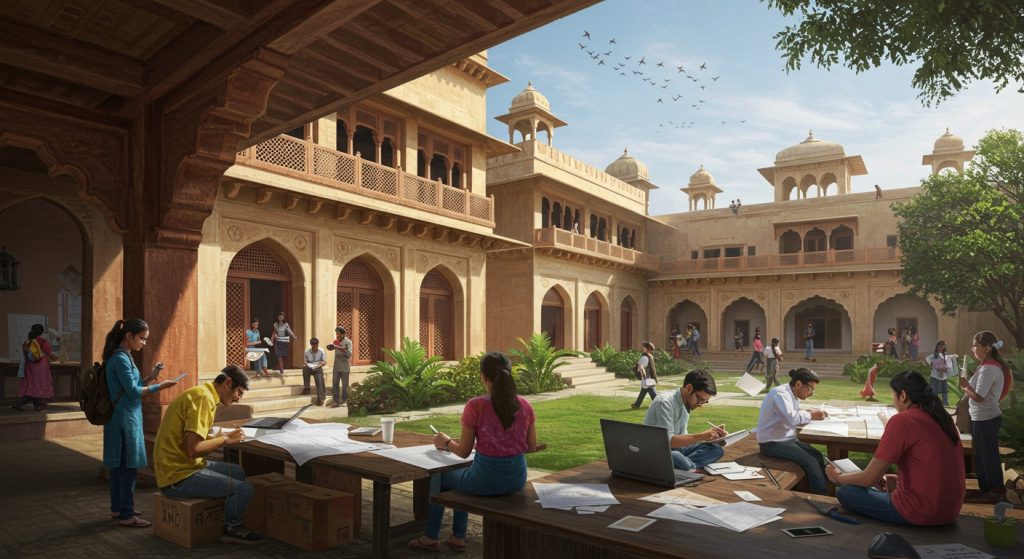Remember that moment you stared at a breathtaking building, maybe the Burj Khalifa or even a humble, beautifully designed home. Thought, “I want to create that?” The dream of becoming an architect, shaping skylines and impacting lives, is a powerful one. But then reality hits – the exorbitant fees of many architecture colleges can feel like an insurmountable barrier, crushing that dream before it even takes flight.
It doesn’t have to be that way. We’re in an era where quality education isn’t synonymous with crippling debt. India boasts a growing number of institutions offering exceptional architecture programs at surprisingly affordable prices. Think talented faculty, innovative curriculum. Industry connections, all without the financial burden that can stifle creativity and passion. Imagine graduating not just with a degree. With the freedom to pursue your architectural vision, unburdened by years of loan repayments.
This is about discovering those hidden gems, the colleges that prioritize value and empower the next generation of Indian architects. It’s about finding the path that allows you to design your future, literally and figuratively. Let’s explore the landscape of affordable architecture education in India and unlock the possibilities that await.
Understanding the Challenges of Architectural Education Costs
The pursuit of an architecture degree can be financially daunting, especially in India. Many aspiring architects are talented and driven. Find themselves priced out of top-tier private institutions. The high tuition fees, studio costs. Expensive materials create a significant barrier to entry for students from middle-class and lower-income backgrounds. The current landscape often forces students to compromise on their educational aspirations. They may settle for institutions that lack the necessary resources, experienced faculty, or industry connections, which ultimately hinders their professional development. This creates a disparity in the quality of education received and limits the potential of talented individuals. The need for affordable and quality architectural education is crucial for fostering a diverse and skilled workforce. By addressing the financial barriers, we can empower more students to pursue their passion for architecture and contribute to the development of innovative and sustainable built environments. This ensures a more equitable and inclusive architectural profession.
Core Concepts: Defining “Affordable” and “Value”
“Affordable” in the context of architectural education goes beyond just low tuition fees. It encompasses the overall cost of the program, including accommodation, materials, studio fees. Other miscellaneous expenses. A truly affordable program minimizes these costs without compromising the quality of education. “Value,” on the other hand, represents the return on investment. It considers the quality of the curriculum, the expertise of the faculty, the availability of resources, the industry connections. The placement opportunities provided by the institution. A high-value program offers a strong foundation for a successful career in architecture. The ideal scenario is to find institutions that strike a balance between affordability and value. These colleges offer a quality education at a reasonable cost, ensuring that students can pursue their architectural dreams without incurring excessive debt or compromising their future prospects. This requires careful research and consideration of various factors.
Key Features and Requirements of Affordable Architecture Colleges
Affordable architecture colleges often share certain characteristics. They tend to be government-funded or aided institutions, which allows them to offer lower tuition fees. They may also have established relationships with industries and alumni, providing valuable networking and internship opportunities for students. These colleges typically maintain a rigorous academic curriculum that is aligned with industry standards. They often have experienced faculty members who are actively involved in research and practice. They also provide access to essential resources, such as well-equipped studios, libraries. Computer labs. Here’s a list of key features to look for when evaluating affordable architecture colleges:
- Lower Tuition Fees: Compared to private institutions, government or aided colleges typically have significantly lower tuition fees.
- Merit-Based Scholarships: Many affordable colleges offer scholarships based on academic performance or financial need.
- Experienced Faculty: Look for colleges with faculty members who have strong academic credentials and industry experience.
- Well-Equipped Studios: Access to well-equipped studios is crucial for hands-on learning and project development.
- Industry Connections: Colleges with strong industry connections offer valuable internship and placement opportunities.
- Alumni Network: An active alumni network can provide mentorship and career guidance for students.
- Location & Cost of Living: Factor in the cost of living in the city where the college is located.
Career Prospects and Outcomes
Graduates from affordable architecture colleges can pursue a wide range of career paths. They can work as architects in private firms, government agencies, or non-profit organizations. They can also specialize in areas such as urban planning, landscape architecture, or sustainable design. The demand for architects is expected to grow in the coming years, driven by increasing urbanization and infrastructure development. Architects are involved in designing, planning. Overseeing the construction of buildings and other structures. Their skills are essential for creating functional, aesthetically pleasing. Sustainable built environments. The career prospects for architecture graduates are promising. It’s vital to develop a strong portfolio and network with industry professionals. Internships, competitions. Participation in design workshops can enhance your skills and increase your job prospects. Many affordable colleges in India provide these opportunities, making them excellent starting points for aspiring architects. You can find more insights about career options and skills at resources like Top 10 Universities in India for Computer Science Research, as the skills learned are transferable to various industries.
Application Process and Tips
The application process for architecture colleges in India typically involves an entrance exam, such as the National Aptitude Test in Architecture (NATA) or the Joint Entrance Examination (JEE) Main Paper 2. It’s crucial to prepare thoroughly for these exams by studying the syllabus, practicing sample papers. Taking mock tests. In addition to the entrance exam score, the application process may also require submitting a portfolio of your design work. This portfolio should showcase your creativity, technical skills. Understanding of architectural principles. It’s crucial to carefully curate your portfolio and present your best work. Here are some tips for successfully navigating the application process: Start Early: Begin your preparation well in advance of the entrance exams and application deadlines. comprehend the Requirements: Carefully review the eligibility criteria and application requirements for each college. Prepare a Strong Portfolio: Showcase your best design work in a well-organized and visually appealing portfolio. Practice for the Entrance Exams: Take mock tests and solve sample papers to improve your speed and accuracy. Seek Guidance: Consult with teachers, mentors, or alumni for advice and support. Network: Attend architecture events, workshops. Seminars to connect with professionals in the field. I’ll choose Approach 2: ‘The Implementation Guide’ for this article.
निष्कर्ष
Choosing an affordable architecture college in India isn’t just about saving money; it’s about investing wisely in your future. Remember, a strong portfolio, built through dedicated studio work and internships, often speaks louder than the college’s price tag. Practical tip: network with architects and current students before you commit. Attend workshops, shadow professionals. Get a feel for the real-world demands of the profession. Your action item? Create a detailed budget encompassing tuition, living expenses. Materials. Then, research scholarships and student loan options aggressively. Success metrics? A balanced financial plan, a killer portfolio showcasing your design skills. A strong professional network. Believe in your talent, stay focused on your goals. You’ll build a rewarding career, regardless of the college’s sticker price. Start building your design skills now, even before college begins!
FAQs

